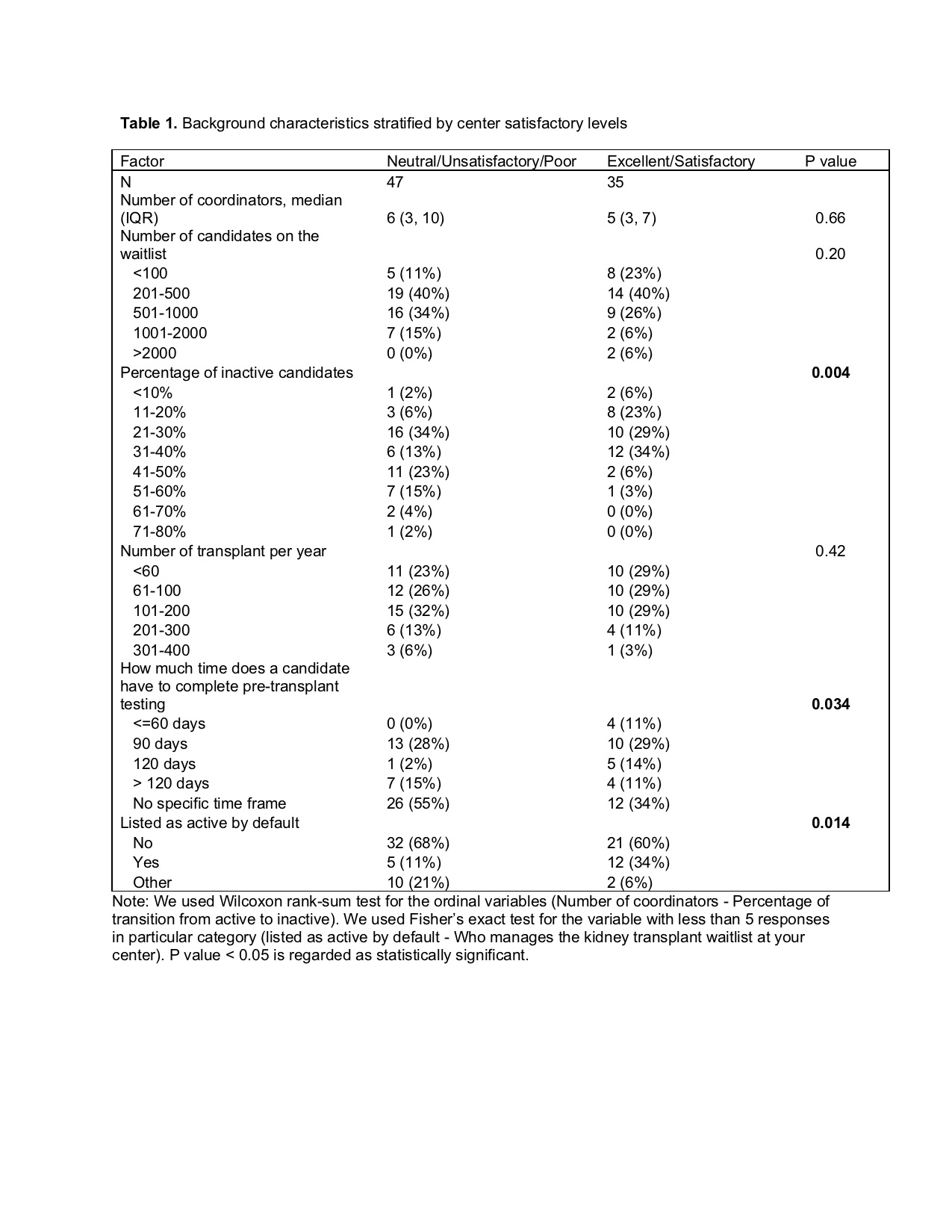Characteristics Associated with Center Satisfaction in Management of the Inactive Kidney Transplant Waitlist
Johns Hopkins School of Medicine, Baltimore, MD
Meeting: 2020 American Transplant Congress
Abstract number: C-015
Keywords: Kidney transplantation, Waiting lists
Session Information
Session Name: Poster Session C: Kidney Deceased Donor Allocation
Session Type: Poster Session
Date: Saturday, May 30, 2020
Session Time: 3:15pm-4:00pm
 Presentation Time: 3:30pm-4:00pm
Presentation Time: 3:30pm-4:00pm
Location: Virtual
*Purpose: As the deceased donor kidney transplant (DDKT) waitlist grows, many centers maintain a large pool of inactive candidates to prioritize those most likely to receive a transplant. We sought to examine centers’ perceptions of their waitlist management strategies and identify factors associated with provider waitlist management satisfaction.
*Methods: Transplant centers with an active kidney program were identified from the OPTN member directory. Surveys were distributed electronically to team member(s) responsible for waitlist management at each center using Qualtrics software from April to November 2018. Wilcoxon rank-sum test and Fisher’s exact test were used to identify waitlist characteristics associated with improved provider satisfaction.
*Results: A total of 82/247 (33%) centers responded to our survey. Among respondents, 47 (57%) rated their inactive waitlist management as neutral, unsatisfactory, or poor. Compared to transplant centers reporting high satisfaction, transplant centers that expressed a need for improvement in waitlist management had a greater percentage of inactive candidates (median: 31-40% vs. 21-30%, p=0.004), allocated more time for candidates to complete pre-transplant testing (median: no specific time frame vs. 120 days, p=0.03) and were less likely to list candidates active by default (11% vs. 34%, p=0.01). When asked about specific strategies utilized to optimize conversion of a candidate from inactive to active status, there were no significant differences in methods employed by centers reporting high vs. low satisfaction. For both cohorts, strategies most commonly cited include reviewing candidates’ status routinely (53 centers, 65%), EMR reminders (18 centers, 22%), relying on transplant coordinator memory and spreadsheets (10 centers, 12.2%), and other miscellaneous approaches (14 centers, 17%).
*Conclusions: Practices and provider satisfaction vary across transplant centers. Further studies to establish best practices may help to minimize provider burden and center dissatisfaction.
To cite this abstract in AMA style:
Hiller J, Chen J, Zhang W, Massie A, Covarrubias K, Jackson K, Long J, DiBrito S, Segev D, Garonzik-Wang J. Characteristics Associated with Center Satisfaction in Management of the Inactive Kidney Transplant Waitlist [abstract]. Am J Transplant. 2020; 20 (suppl 3). https://atcmeetingabstracts.com/abstract/characteristics-associated-with-center-satisfaction-in-management-of-the-inactive-kidney-transplant-waitlist/. Accessed December 17, 2025.« Back to 2020 American Transplant Congress

